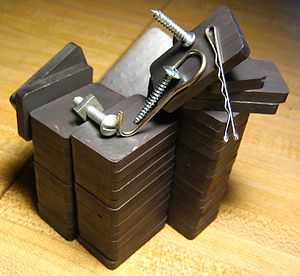
Back فريت (مغناطيسية) Arabic Ferrita (imant) Catalan Feritový magnet Czech Ferrite German Ferito (magnetismo) Esperanto Ferrita (cerámica ferromagnética) Spanish Ferriit (elektrotehnika) Estonian فریت (آهنربا) Persian Keraaminen magneetti Finnish Ferrite (céramique ferromagnétique) French

A ferrite is an iron oxide-containing magnetic ceramic material. They are ferrimagnetic, meaning they are attracted by magnetic fields and can be magnetized to become permanent magnets. Unlike many ferromagnetic materials, most ferrites are not electrically conductive, making them useful in applications like magnetic cores for transformers to suppress eddy currents.[1]
Ferrites can be divided into two families based on their magnetic coercivity, their resistance to being demagnetized:[2]
"Hard" ferrites have high coercivity, so are difficult to demagnetize. They are used to make permanent magnets for applications such as refrigerator magnets, loudspeakers, and small electric motors.
"Soft" ferrites have low coercivity, so they easily change their magnetization and act as conductors of magnetic fields. They are used in the electronics industry to make efficient magnetic cores called ferrite cores for high-frequency inductors, transformers and antennas, and in various microwave components.
Ferrite compounds are extremely low cost, being made mostly of iron oxide, and have excellent corrosion resistance. Yogoro Kato and Takeshi Takei of the Tokyo Institute of Technology synthesized the first ferrite compounds in 1930.[3]
- ^ Spaldin, Nicola A. (2010). Magnetic Materials: Fundamentals and Applications, 2nd Ed. Cambridge University Press. p. 120. ISBN 9781139491556.
- ^ Connor, Nick (2023-07-24). "Ferrite | Formula, Properties & Application". Material Properties. Retrieved 2024-03-29.
- ^ Okamoto, A. (2009). "The Invention of Ferrites and Their Contribution to the Miniaturization of Radios". 2009 IEEE Globecom Workshops. pp. 1–42. doi:10.1109/GLOCOMW.2009.5360693. ISBN 978-1-4244-5626-0. S2CID 44319879.
© MMXXIII Rich X Search. We shall prevail. All rights reserved. Rich X Search